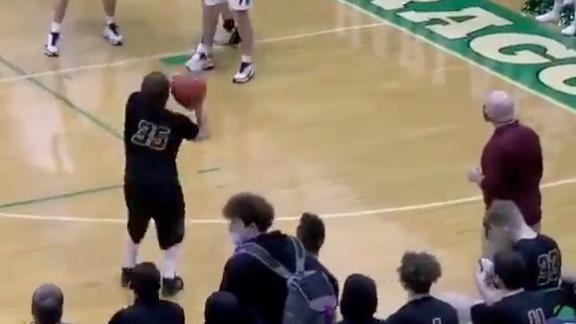The revitalized eastern half of downtown Long Beach is known as the East Village Arts District. As its name suggests, the neighborhood is home to numerous artisanal boutiques, art galleries and artists' lofts. The East Village also happens to be where a store called The Deviant Design Group (DDG) opened its doors in 2005. There, Mark Barata -- DDG's 29-year-old owner -- labors at a truly unique art form: ornate, lustrous jewelry expressly designed for professional skateboarders.
You heard that correctly.
Mark Barata is a jeweler whose most prominent clients are pro skaters. If you have ever noticed sumptuously bejeweled rings, pendants, medallions, earrings, watches and chains on high-profile skateboarders like Ryan Sheckler, Rob Dyrdek and Paul Rodriguez, most of it likely originated at DDG and was personally fashioned by the Long Beach-born Barata. He is the skateboard community's preferred purveyor of precious gemstones. No merchant has sold more diamonds and jewels to this newly affluent Action Sports subset, catered to this demographic more assiduously, and so swiftly claimed this emerging commercial territory. If there were a Guinness Record for "Most Diamonds Sold to Skaters" Mr. Barata could easily win it year after year.
"Danny Way. Colin McKay. P-Rod. I did stuff for Sheckler. I did all of Rob [Dyrdek's] jewelry," Mr. Barata recently told ESPN.com with an amiable laugh. "I put together a couple diamond stud earrings for Danny's wife. I did a bunch of stuff for Chaz Ortiz. Greg Luztka. I did every single piece of jewelry for him. I made Greg five hundred rubies on a skateboard... It's been cool, you know?"
"Luztka's piece was one of the most fun to make because it was so many rubies," continued Barata. "I believe, in total, it was 588 rubies. It's an all black skateboard with all red rubies. It came out really, really nice. Greg was just like, 'Let's just go all out on this one and put as many rubies on it as we can.' He loves black and red."
Barata also designed Street League's 2011 diamond-encrusted championship watch and ring set. Other clients have included well-established brands like Red Bull, Monster and DC shoes.
The unassuming Southern Californian-native still skates to work, and makes a point to tell potential customers he does not conform to popular notions and stereotypes of what a jeweler is or should be.
"I am fully tatted, double sleeves," Barata said. "I can't stand going into a store and getting, like, an 80-year-old guy in a suit and tie trying to romance you on a stone. I'm not that type of guy. I almost apologize on behalf of every jeweler in the world, for that. We're a lot different in that aspect. So when you walk into our store, you're not going to get that."
Diamonds and Rubies and Battle-Axes Are Forever
On the day of our interview Barata had just completed a battle-axe pendant for the former professional skateboarder, MMA fighter, and radio host Jason Ellis and was preparing to deliver the ruby-accented chest ornament to Ellis, on air.
"Jason's a gnarly dude," said Barata. "He just comes up with these crazy ideas and leaves it in my hands to bring to life. A couple weeks ago he said he wanted a huge battle-axe. Super medieval and crazy. Rhodium plated and black. I made him a three finger skull ring, too. It's called 'The Headhunter' because he's an MMA fighter."
Barata has also appeared in episodes of Rob Dyrdek's reality television programs Rob and Big and Fantasy Factory. Dyrdek is a longtime friend and client of Barata's and was an original investor in DDG. "I am not going to lie," Barata said, laughing. "Rob Dyrdek knows a lot about diamonds."
Because Barata is relatively young and makes a living selling blinged out jewelry to fast living pro skaters, you might assume his favorite movie is Scarface.
You'd be right.
"The jewelry industry is the closest thing to drug dealing in the world. There's not too many places where you go and spend thousands of dollars on a little rock. You know? And everybody wants them. And people will kill you for jewelry. So my favorite movie growing up was Scarface," he said. "Scarface is a coming-of-age tale where he came from nothing and rose to power. Every man, at one point or another, would love to be on his [Scarface's] throne."
Yet for a diamond dealer devoted to feeding the upscale skater's growing addiction to opulent aesthetic objects, Barata is a surprisingly down-to-earth dude. Nonetheless, he is a dude who was always more fascinated than most dudes by his own birthstone -- you guessed it, a diamond. As a small child he loved drawing and sketching cars and thought about becoming a car designer. But in high school Barata took a particular liking to metal shop. (Barata fell even further in love with gemology when -- early in his career as a retail sales associate at the Newport Beach, Calif. jewelry store Black, Starr & Frost -- he was able to hold the famous Archduke Joseph Diamond in his hand. The diamond is an internally flawless and colorless stone that weighs 76.02 carats. As of this writing, the Joseph Diamond was days away from being auctioned at Christie's and had a low estimate of $15 million.) From there, Barata went on to attend the Jewelry Arts and Design College, based in Los Angeles, where he eventually rose to the rank of instructor in 3D jewelry design.
"I am actually the only certified instructor in California in a 3D CAD CAM software called 3D design," said Barata. (CAD and CAM are acronyms for "Computer-aided design" and "Computer-aided manufacturing.")
Paul Rodriguez: Lord of the Ring
Without realizing it, I had actually encountered Mr. Barata's brash, rococo artistry this past August in Ocean City, Maryland at a small Mountain Dew-sponsored cocktail party featuring the immaculately well-mannered guest of honor Paul Rodriguez. For about an hour Rodriguez and I sat at a private table and discussed a host of weighty issues such as his recently earned X Games gold medal, the power of prayer, and Muhammad Ali. Yet, I must admit, I spent much of the conversation surreptitiously marveling at the even weightier diamond-caked pinky ring Rodriguez wore and periodically fiddled with.
The audacious diamond-studded, 500 carat, 1,000 watt ring seemed to be something only Rodriguez -- the crown prince of mainstream skateboarding -- could carry off. It was a regal accoutrement truly fit for a young Target, AT&T, Nike and Mountain Dew-sponsored king. One ring to rule them all!
The ring was also interesting in that it was one of the strikingly few exceptions to Rodriguez's otherwise modest personal presentation. The impossibly abundant diamonds were abstractly arrayed on the ring in a way that seemed to suggest a skateboard. Was that what the ring was, a reporter wondered? A diamond-studded skateboard? Wouldn't that be symbolic? (In 2008, Forbes ranked Rodriguez the seventh highest paid action sports athlete.)
Alas, this intrepid reporter never mustered the courage to actually ask Rodriguez a single thing about it. I didn't want to sound unsophisticated. I didn't want to say something like, "Wow, so that certainly seems like a lot of diamonds on your pinky." Or, "Would you describe your ring as 'swag'?" Or, "Would you mind if I try that on for a second while I wave my arms about and call out 'YOLO!' 'Ride or die!' and 'Skate Life!?'"
Fortunately, it turned out Mark Barata had -- not surprisingly -- made Rodriguez's "flossy" pinky ring and was able to authoritatively sate a reporter's curiosity regarding it.
"Yeah, that is a completely diamond-encrusted ring and he wears it on his pinky. It has all white diamonds and then one little row of canary yellow diamonds," Barata said. "That was nine carats total. We put as many diamonds as we possibly could on it. He got that kind of as a trophy, because he had just won the Maloof Money cup, and that was a big deal for him. The yellow diamonds spell a 'B.'The 'B' stands for Plan B, his sponsor. A lot of skaters get their sponsor logos."
"Being a pro skater is a lot different than it was in the '80s and '90s," said Barata. "The sponsors are a lot bigger. This would have never happened 20 years ago. Tony Hawk was the one who lead the way. Times have changed. Guys are getting paid a lot more to do their art or discipline."
Now You (And Big Black) Have a Friend in the Diamond Business
But Rodriguez's baroque ring is far from being the most remarkable objet d'art Mark Barata has ever made. That distinction probably belongs to a piece of custom jewelry Barata created for Christopher "Big Black" Boykin -- Rob Dyrdek's erstwhile roommate, BFF, bodyguard and the costar of the eponymous MTV reality television show Rob and Big.
"We actually laser-scanned Big Black's head and we turned it into a pendant," said Barata. "It's super crazy. It was an identical replica of his face. It's never been done before. And I don't think it's been done since."
"It was a present from Rob," continued Barata. "He [Mr. Boykin] went crazy."
Barata also designed Rob Dyrdek's "shoe chain" -- a gold necklace composed of a replica of every one of Dyrdek's pro model shoes. (The chain utilized a pound of gold.)
"I sent every one of his shoes to Minneapolis, Minnesota and had it laser-scanned to a thousandth of an inch," said Barata. "That is how we were able to replicate it with such precision."
*Of course, proffering diamonds and precious metals to prosperous professional skateboarders is not without inherent risk.
"I get a lot of banged up rings sent back, to get repaired," said Barata. "I definitely I have gotten a handful of rings that are obliterated from a fall or a spill."
"If you want to wear it when you're skating, when you break it, just come back to me," he added. "And I'll fix it for you."
Still, however unstable or novel the marriage between professional skateboarding and precious gemstones may seem, there is a certain timelessness, if not inevitability, to the attraction.
After all, fashion statements of this kind do not lack historical precedent.
"In Europe before the eighteenth century (in medieval and Renaissance Europe), men wore gaudy clothing and lots of jewelry," Paul H. Freeman, a professor of history at Yale University who specializes in medieval social history, comparative studies of the peasantry and trade in luxury products, said in an email. "For aristocrats of the Middle Ages [jewelry often meant] 'the gods favor me.' There were so-called 'sumptuary laws' that tried to regulate luxury clothing and flaunting of gems for men and women. [The belief was] only members of certain classes or orders had the right to wear, for example, fur-trimmed garments or jeweled belts. With the development of industry -- and so a new kind of wealth -- the emphasis for wealthy men was on sobriety and enterprise. Men began dressing in dark colors, suits and although quality variations were important, they were subtle."
"Rare, durable, and beautiful; the definition applies both to athletic skill and to gems. These stones capture the imagination just as sports and athletes do," Stephen B. Morisseau, Director of Public Relations for the Gemological Institute of America, said in an email. "For centuries gems have celebrated achievement and achievement in sport is no exception."
So, perhaps skateboarders and diamonds can look forward to a long and beautiful future together.




